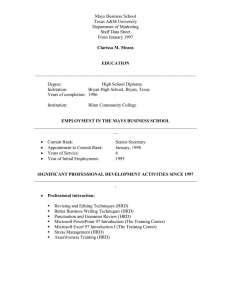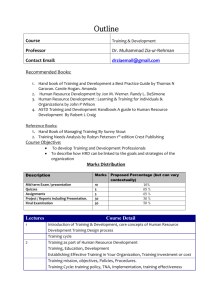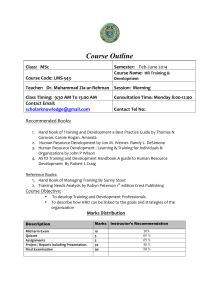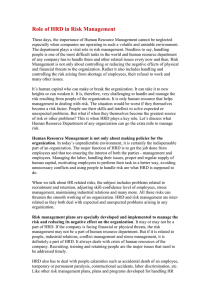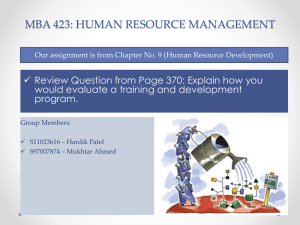IJMRA-ESM2236
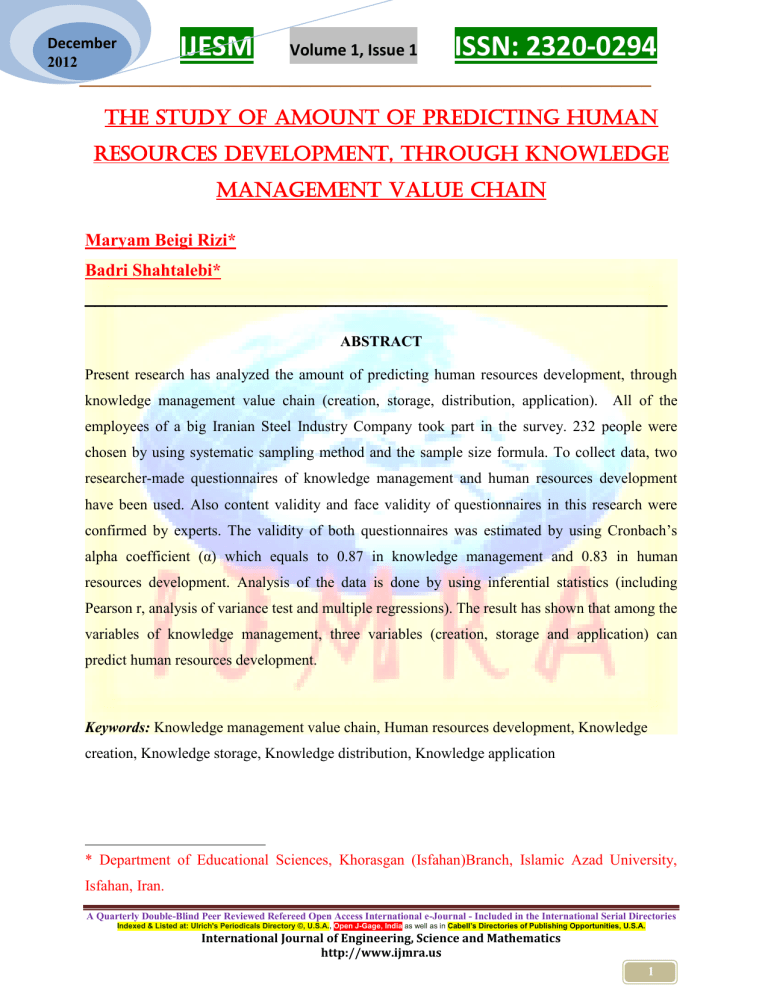
2012
IJESM
Volume 1, Issue 1
ISSN: 2320-0294
_________________________________________________________
THE STUDY OF AMOUNT OF PREDICTING HUMAN
RESOURCES DEVELOPMENT, THROUGH KNOWLEDGE
MANAGEMENT VALUE CHAIN
Maryam Beigi Rizi*
Badri Shahtalebi*
__________________________________________________________
ABSTRACT
Present research has analyzed the amount of predicting human resources development, through knowledge management value chain (creation, storage, distribution, application). All of the employees of a big Iranian Steel Industry Company took part in the survey. 232 people were chosen by using systematic sampling method and the sample size formula. To collect data, two researcher-made questionnaires of knowledge management and human resources development have been used. Also content validity and face validity of questionnaires in this research were confirmed by experts. The validity of both questionnaires was estimated by using Cronbach’s alpha coefficient (α) which equals to 0.87 in knowledge management and 0.83 in human resources development. Analysis of the data is done by using inferential statistics (including
Pearson r, analysis of variance test and multiple regressions). The result has shown that among the variables of knowledge management, three variables (creation, storage and application) can predict human resources development.
Keywords: Knowledge management value chain, Human resources development, Knowledge creation, Knowledge storage, Knowledge distribution, Knowledge application
* Department of Educational Sciences, Khorasgan (Isfahan)Branch, Islamic Azad University,
Isfahan, Iran.
A Quarterly Double-Blind Peer Reviewed Refereed Open Access International e-Journal - Included in the International Serial Directories
Indexed & Listed at: Ulrich's Periodicals Directory ©, U.S.A., Open J-Gage, India as well as in Cabell’s Directories of Publishing Opportunities, U.S.A.
International Journal of Engineering, Science and Mathematics http://www.ijmra.us
1
2012
IJESM
Volume 1, Issue 1
ISSN: 2320-0294
_________________________________________________________
1 INTRODUCTION
Entering the third millennium, human is observing rapid environmental changes, increasing competition sensitivity, globalizing economy, fundamental change in the business world, the cyberspace, appearing the intellectual capital and knowledge workers in organizations. These are creators of new scenarios that knowledge management is one of them. So in recent years, different organizations have been joining the process of knowledge and new concepts such as knowledge work, knowledge worker, knowledge management and knowledge organizations show the intensity of this process. Through these concepts, Draucker introduced new organizations in which, mental strength ruled rather than physical strength. According to this theory, in future, communities which can expect development and progress that have more knowledge. Thus having natural resources cannot be as important as knowledge. Knowledge organization will achieve the abilities which are able to make enormous strength of little power [1]. Toward this end, most of the organizations have understood that achieving success or even surviving; need something more than achieving knowledge randomly or shortly and there is no way except applying an appropriate knowledge management system [2]. KM is the process of acquiring knowledge from the organization or another source and turning it into explicit information that the employees can use to transform into their own knowledge allowing them to create and increase organizational knowledge [3]. Fundamentally, knowledge management is about applying the collective knowledge of the entire workforce to achieve specific organizational goals. The aim of knowledge management is not necessarily to manage all knowledge, just the knowledge that is most important to the organization. It is about ensuring that people have the knowledge they need, where they need it, when they need it – the right knowledge, in the right place, at the right time
[4]. (Moreover The goal of KM is to improve tasks and sub-tasks, in most cases the creation or generation; acquisition; identification or capture; validation and evaluation; conversion; organization and linking; formalization or storage; refinement or development; distribution, diffusion, transfer or sharing; presentation or formatting; application and evolution of knowledge, with the help of systematic interventions, instruments or measures
[5],[6],[7],[8],[9],[10],[11],[12]. (Schuppel & et al., 1996; Wiig & et al. 1997; Probst, 1998;
O'Dell and Grayson, 1999; Alavi and Leidner, 2001; Bhatt, 2001; Choo, 2006; Maier, 2007).
What we can do, and what the ideas behind knowledge management are all about, is to establish an environment in which people are encouraged to create, learn, share, and use knowledge
A Quarterly Double-Blind Peer Reviewed Refereed Open Access International e-Journal - Included in the International Serial Directories
Indexed & Listed at: Ulrich's Periodicals Directory ©, U.S.A., Open J-Gage, India as well as in Cabell’s Directories of Publishing Opportunities, U.S.A.
International Journal of Engineering, Science and Mathematics http://www.ijmra.us
2
2012
IJESM
Volume 1, Issue 1
ISSN: 2320-0294
_________________________________________________________ together for the benefit of the organization, the people who work in it, and the organization's customers. Actually, creating a knowledge environment usually requires changing organizational values and culture, changing people’s behaviors and work patterns, and providing people with easy access to each other and to relevant information resources [4]. The success of knowledge management requires a systematic attitude which consists of all elements and components and knowledge management process. Any detailed look might create serious challenges in the way of success of knowledge management plans. In this regard Shin (2001) defines Knowledge management value chain (KMVC) as a process with four major activities of creation, storage, distribution and application in KM field, which create value for organization via knowledge [13].
Although different researchers have suggested various models to implement knowledge management system in the organization, all of them originate from these four levels. As Argyris
(1991) points out: ‘The nuts and bolts of management… increasingly consists of guiding and integrating the autonomous but interconnected work of highly skilled people [14].’ Knowledge management is about the management and motivation of knowledge workers who create knowledge and will be the key players in sharing it. Consequently HR can make an important contribution to knowledge management simply because knowledge is shared between people; it is not only a matter of capturing explicit knowledge through the use of information technology but also the distinctive human resource practices help to create unique competencies that differentiate products and services and, in turn, drive competitiveness [15]. Strengthening factors like dutiful and serious personnel, employee relations, upgrade human resource competencies in organization, and also making a change in organizational culture can act as catalysts to implement management systems [16]. In fact, educating elite and skilled people who is called human resource development is an unavoidable necessity that organizations require strongly to survive and develop in today's changeable world [17]. Briefly the purposes and goals of HRD are: 1) Ensuring congruence between individual and organizational goals and objectives and setting high standard of productivity, efficiency and quality of working life; 2) Enriching employee commitment and role effectiveness through sharing of information regarding mutual rights, obligations and the philosophy, underlying man-management policies and system; 3) Improving organizational effectiveness by providing due guidance to executives and staff in uniform and effective implementation of management policies especially in the area of human resources and 4)
Developing collaborative and problem solving approaches in human resource development [18].
A Quarterly Double-Blind Peer Reviewed Refereed Open Access International e-Journal - Included in the International Serial Directories
Indexed & Listed at: Ulrich's Periodicals Directory ©, U.S.A., Open J-Gage, India as well as in Cabell’s Directories of Publishing Opportunities, U.S.A.
International Journal of Engineering, Science and Mathematics http://www.ijmra.us
3
2012
IJESM
Volume 1, Issue 1
ISSN: 2320-0294
_________________________________________________________
HRM practices can also provide people the motives and incentives to participate in KM processes. In knowledge dependent organizations, employees must be willing and motivated to share their education and experience with other employees in order to generate innovation.
2
THEORİCAL FRAME OF RESEARCH
HRD facilitate knowledge flows and innovation by improving employees’ ability, motivation and opportunity to access and mobilize one another’s knowledge and then transform it into new knowledge and ideas [19]. In knowledge dependent organizations, employees must be willing and motivated to share their education and experience with other employees in order to generate innovation, so HRD practices can provide people the motives and incentives to participate in KM processes [19]. HRD and KM share common activities and purposes while forming work units, teams and multi-functional cooperation and also communication networks within and boundaries of organization. All in all if there is a comparison between KM cycle and HRD processes, it will be difficult to find an area where they have no share. So, present research has tried to survey the amount of predicting human resources development, through knowledge management value chain.
3 METHODOLOGY
Present research has analyzed the amount of predicting human resources development, through knowledge management value chain by descriptive method in correlation type. 1221 employees of one of the Iranian Steal Company with B.S degree and upper took part in the statistical population of this survey. 232 people were chosen by using systematic sampling method and the sample size formula. To collect data, two researcher-made questionnaires of knowledge management and human resources development have been used. Also content validity and face validity of questionnaires in this research were confirmed by experts. The validity of both questionnaires was estimated using Cronbach’s alpha coefficient (α) which equals to 0.87 in knowledge management and 0.83 in HRD.
A Quarterly Double-Blind Peer Reviewed Refereed Open Access International e-Journal - Included in the International Serial Directories
Indexed & Listed at: Ulrich's Periodicals Directory ©, U.S.A., Open J-Gage, India as well as in Cabell’s Directories of Publishing Opportunities, U.S.A.
International Journal of Engineering, Science and Mathematics http://www.ijmra.us
4
2012
IJESM
Volume 1, Issue 1
ISSN: 2320-0294
_________________________________________________________
4 HYPOTHESİS
Knowledge management value chain dimensions have predictability of human resource development in organization.
Table 1, Multiple Correlation Coefficient KMVC dimensions in predicting HRD
Dependent variable
Independent variable
First Step
Knowledge Application
Squared
Multiple
Correlation
Correlation
Coefficient
Multiple
Coefficient
Squared
Multiple
Correlation
Coefficient of
Moderated
0.836 0.699 0.698
F P
448.931 0.001
Second Step
Knowledge Application
Human
Knowledge Creation
Resource
Development
Third Step
Knowledge Application
Knowledge Creation
Knowledge Storage
0.857
0.861
0.735
0.742
0.732
0.738
266.121 0.001
182.710 0.001
As finding of table 1 show, among the studied variables in regression, the best predicator of HRD in the first step is knowledge application and in the second step, they are knowledge application, knowledge creation and in the third step they are knowledge application, knowledge creation and knowledge storage. According to stepwise multiple regression analysis of results the relation between knowledge application, knowledge creation and knowledge storage with HRD is meaningful. Accordingly in the first step, knowledge application dimension coefficient, 83.6% variance of HRD and in the second step, knowledge application, knowledge creation dimensions coefficients, 85.7% variance of HRD and in the third step, knowledge application, knowledge creation and knowledge storage dimensions coefficients, 86.1% variance of HRD have expressed.
A Quarterly Double-Blind Peer Reviewed Refereed Open Access International e-Journal - Included in the International Serial Directories
Indexed & Listed at: Ulrich's Periodicals Directory ©, U.S.A., Open J-Gage, India as well as in Cabell’s Directories of Publishing Opportunities, U.S.A.
International Journal of Engineering, Science and Mathematics http://www.ijmra.us
5
2012
IJESM
Volume 1, Issue 1
ISSN: 2320-0294
_________________________________________________________
Also F at the level of P< 0.01 is meaningful so the regression is extensible to statistical population.
Table 2, Beta coefficient in prediction of HRD
Dependen t variable
Independent variable
First Step Knowledge
Application
Non-
Standardized beta coefficients
Beta
Standa rd error
Standard ized beta coefficie nts
1.97
6
0.093 0.836
Human
Resourc e
Develop ment
Second Step Knowledge
Application
Knowledge
Creation
Third Step Knowledge
Application
Knowledge
Creation
Knowledge
Storage
1.54
2
0.78
6
1.41
8
0.66
4
0.38
2
0.123
0.155
0.134
0.163
0.172
0.653
0.263
0.600
0.222
0.119 t
21.1
88
12.5
88
5.07
4
10.6
19
4.08
1
2.22
4
P
0.00
1
0.00
1
0.00
1
0.00
1
0.00
1
0.02
7
Findings of table 2 show that when knowledge application dimension increases one unit, then
Beta coefficient increases HRD, 0.600 unit and when knowledge creation dimension increases one unit, then Beta coefficient increases HRD, 0.222 unit, also when knowledge storage dimension increases one unit, then Beta coefficient increases HRD, 0.119 unit. Therefore, according to table 2, regression equation (in the third steps of stepwise multiple regression analysis) to predict HRD is as follows:
HRD= coefficient of stability (31.322) + Knowledge application dimension (1.418) + knowledge creation dimension (0.664) + knowledge storage dimension (0.382).
According to table 3, the relation between knowledge distribution dimensions with HRD was not meaningful.
Table 3, exogenous variables in regression equation to predict HRD
A Quarterly Double-Blind Peer Reviewed Refereed Open Access International e-Journal - Included in the International Serial Directories
Indexed & Listed at: Ulrich's Periodicals Directory ©, U.S.A., Open J-Gage, India as well as in Cabell’s Directories of Publishing Opportunities, U.S.A.
International Journal of Engineering, Science and Mathematics http://www.ijmra.us
6
2012
IJESM
Volume 1, Issue 1
ISSN: 2320-0294
_________________________________________________________
First Step
Knowledge
Creation
Knowledge
Storage
Knowledge
Distribution
Second Step
Knowledge
Storage
Knowledge
Distribution
Beta
0.263
0.192
0.222
0.119
0.100 t
5.074
3.670
3.566
2.224
1.464
P
0.001
0.001
0.001
0.027
0.145
Third Step
Knowledge
Distribution
0.067 0.952 0.343
5 CONCLUSION
The main task of HRD is supervision, assessment and involvement in the structure of creation, distribution and application knowledge of employee and in addition the set of HRD activities has a great influence on creating and maintaining capabilities and abilities of employees in organization.
According to the experts KM is an integrated and systematic approach in identifying, capturing, retrieving, sharing and assessment of enterprise's information assets which includes data base, documents, procedures, policies as well as tacit expertise and experience resident in individual workers. With this approach, KM is able to challenge HR in intellectual dimensions, occupational identity and their unique differences and in this regard it will create sustainable competitive advantages. KM's perspective drives HRD purposes into creating, educating and revising resources and organizational interactivities. The result of survey showed that successfully implementing of
KM and applying it, is one of the most important factors to increase the amount of predicting
HRD. In the other word HRD is possible when the process of knowledge and applying it, is attended completely. If modern knowledge is used in organization, it can be claimed that HRD has
A Quarterly Double-Blind Peer Reviewed Refereed Open Access International e-Journal - Included in the International Serial Directories
Indexed & Listed at: Ulrich's Periodicals Directory ©, U.S.A., Open J-Gage, India as well as in Cabell’s Directories of Publishing Opportunities, U.S.A.
International Journal of Engineering, Science and Mathematics http://www.ijmra.us
7
2012
IJESM
Volume 1, Issue 1
ISSN: 2320-0294
_________________________________________________________ happened. As table 3 shows, in this industrial company there is no meaningful relation between distributing knowledge and HRD and three variables containing- creating knowledge, storing knowledge and applying knowledge- can predict HRD. The world that knowledge has been changed to capital and competitive advantages of organizations, it is possible to claim that the more developed organizations in HR dimension have had more powerful strategies in the KM context. KM and its related processes are intelligent intellectual systems which can educate professional employees and have strategic view to human resources. This attitude has provided the base of employee's consultation in organization and facilitates investment in learning; show the values of learning, identification the intellectual models, establishment the thinking systems and distribution of learning culture and finally human resource development. Also HRD underlines active organizational development, optimized patterns, emphasizing on quality of products and services, the increase of conceptual and operational and organizational results.
REFERENCES
[1] Alvani, M., &Danaee fard, H. (2009). Philosophy of theories in state organizations. Tehran:
Eshraghi.
[2] Taghavi, M., &Shafi zadeh, H. (2009). The principles and foundations of knowledge management. Journal of Rosh fanavari , 18, 48-55.
[3] King, W.R. (2009). Knowledge management and organizational learning, Annals of
Information System. 4. USA: Springer Science Business Media, (Chapter 1).
[4] Servin, G. (2005). ABC of knowledge management, NHS National Library for Health:
Specialist library knowledge management.
[5] Schuppel, J., & Muller-Stewens, G., and Gomez, P. (1996). The knowledge spiral. In G.
Krough, J. Roos, and D. Kleine (Eds.), Knowing In Firms, Thousand Oaks, (pp. 223-252) CA:
Sage Publications.
[6] Wiig, K., & Hoog, R., and Spek, R. (1997). Supporting knowledge management: a selection of methods and techniques. Expert Systems with Applications, 13, 15-27.
[7] Probst, G.B. (1998). Practical knowledge management: a model that works. Prism, Second
Quarter, 17-29.
[8] O'Dell, C., & Grayson, Jr. (1999). Knowledge transfer: Discover your value proposition.
Strategy & Leadership, 27, (pp.10 –15). MCB UP Ltd.
A Quarterly Double-Blind Peer Reviewed Refereed Open Access International e-Journal - Included in the International Serial Directories
Indexed & Listed at: Ulrich's Periodicals Directory ©, U.S.A., Open J-Gage, India as well as in Cabell’s Directories of Publishing Opportunities, U.S.A.
International Journal of Engineering, Science and Mathematics http://www.ijmra.us
8
2012
IJESM
Volume 1, Issue 1
ISSN: 2320-0294
_________________________________________________________
[9] Alavi, M., & Leidner, D.E. (2001). Review: Knowledge management and knowledge management systems: conceptual foundations and research issue. Mis Quarterly, 25, 107-136.
[10] Bhatt, G. (2001). Knowledge management in organizations: examining the interaction between technologies, techniques, and people. Journal of Knowledge management , 5, 68-75.
[11] Choo, C.W. (2006). The knowing organization. How organizations use information to construct meaning, create knowledge, and make decisions. (2nd ed.). New York: Oxford
University, (Chapter 1).
[12] Maier, R. (2007). Knowledge management systems. Information and communication
Technologies for knowledge management. (3rd ed.). Austria: Springer- Verlag Berlin
Heidelberg, (Chapter 2).
[13] Shin, M., Holden, T., & Schmidt, R.A. (2001).From knowledge theory to management practice: towards an integrated approach Original Research Article Information Processing &
Management, 37, 335-355.
[14] Argyris, C. (1991) Teaching smart people how to learn, Harvard Business Review, May-
June, pp 54–62.
[15] Armstrong, M. (2006). A handbook of human resource management practice. (10th ed.).
Printed and bound in Great Britain by Cambridge University Press, (Chapter 35).
[16] Yang, C. (2006). The impact of human resource management practices on the implementation of total quality management: An empirical study on high-tech firms. The TQM Magazine , 18,
162 – 173.
[17] Metani, M., & Hassanzadeh, R. (2008). Effect of in-service training on staff performance
(case study in Azad university of Sari). Journal of education in Azad University of Bojnourd .
15, 159-179.
[18] Lakshmi, C.S. (2005). Human resource development in public enterprises. India: Discovery
Publishing House.
[19] Pastor, I.M.A., Perez Santana, M.A.P., & Sierra, C.M. (2010). Managing knowledge through human resource practices: empirical examination on the Spanish automotive industry. The
International Journal of Human Resource Management , 21, 2452-2467.
[20] Nonaka, I., and Takeuchi, H. (1995). The knowledge-creating company. New York: Oxford
University Press.
A Quarterly Double-Blind Peer Reviewed Refereed Open Access International e-Journal - Included in the International Serial Directories
Indexed & Listed at: Ulrich's Periodicals Directory ©, U.S.A., Open J-Gage, India as well as in Cabell’s Directories of Publishing Opportunities, U.S.A.
International Journal of Engineering, Science and Mathematics http://www.ijmra.us
9
